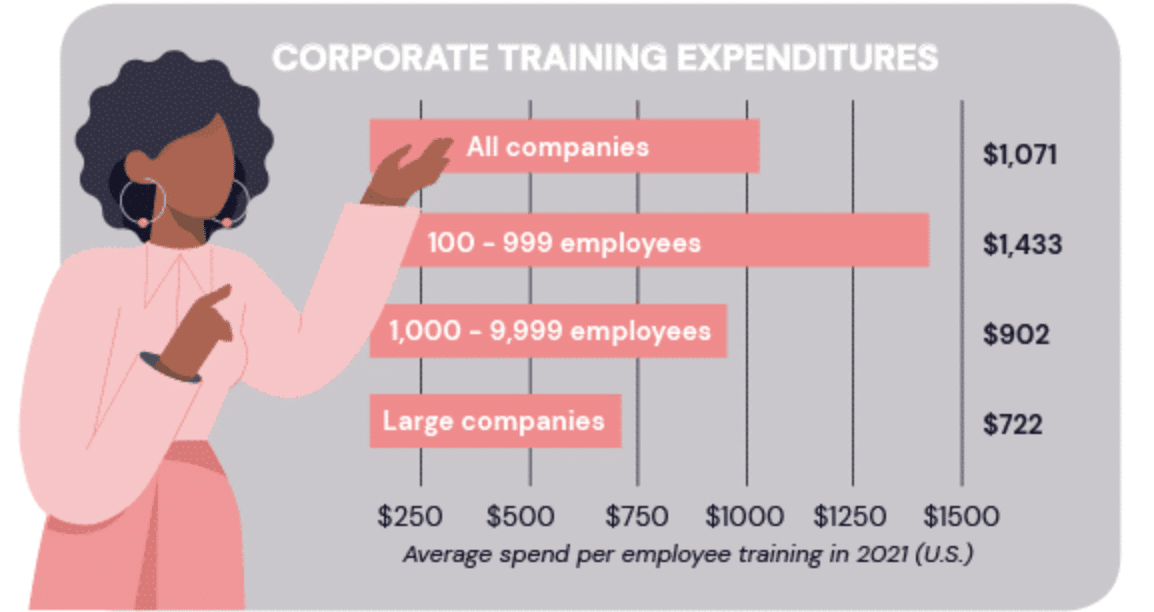Here’s something no one can deny: Feedback is the cornerstone of quality improvement. And this applies to online training! So, today you’re going to step into the art of asking online training evaluation questions.
We’re going to focus on the post-training survey. Think of it as your tool to figure out what went wrong (and well) with your online training course or program.
We’re also going to share a comprehensive set of sample training evaluation questions you can use. Ready? Let’s get going!
What Is a Post-training Survey For?
Post-training evaluation questions assess the effectiveness of a training course. And you have to ask those questions to the staff members who took the course.
A post-training survey is the best option to obtain feedback about the training you offer. You can do it at no cost other than the time you spend creating it in a survey tool that will deploy it for you.
Survey questions for training evaluation investigate the learning conditions you offered throughout the course. The main goal of asking those questions is to optimize the learning conditions for the next time you offer the same training course.
But what does it mean that you had the learning conditions in place when you delivered the course? Well, that means your employees feel that they
- Learned what they were expecting to learn
- Earned information that is useful in carrying out their jobs
Now, it’s one thing to evaluate learning conditions; it’s another thing to assess the actual learning and its applicability to the workplace. That’s when training evaluation survey questions get more course-specific. And the answers should help you understand what your staff actually learned through your course and how helpful that’ll be at work.
Additionally, a post-training survey is an excellent way for your employees to suggest improvements. Many of your team members might have some ideas to uplift your training but not know how to express them. Or they might be shy or afraid of being criticized if they give you their honest feedback. With a survey, you remove those roadblocks and help your staff share their thoughts openly with you.
You also show your workforce that you care about what they think of your training. You prove that your company is invested in including them in the development of your educational projects. Finally, you prove that your business can only grow with their input, and that they’re a valuable part of it.
Next, we’ll look into the insights that the answers to virtual training evaluation questions should give you.
What Conclusions Can You Draw From Post-training Evaluation?
At a high level, asking training evaluation questions of your employees translates to questions about the:
- Course or program
- Training methods and the technology you used to deliver training
- Training content
- Instructors (if you deliver virtual instructor-led training, or VILT)
- Learning outcomes
- Learning activities
- Learning assessment methods
By asking post-training survey questions on these topics, you’ll mainly unfold:
- The training effectiveness
- Factors that contributed to the success (or failure) of your course or program
- Ways in which you can improve the course
If you want to get more specific, post-training evaluation enables you to make conclusions about:
- The popularity of your courses—or the courses your staff prefers taking or will likely recommend taking
- The instructors your employees liked the most (if you offer VILT)
- The content your team members engaged with the most
- The training methods or learning technology that prevented effective learning from taking place or your workforce from achieving the learning outcomes
- The training needs that your course didn’t satisfy
- The learning activities and assessment methods that didn’t work as you expected them to
Then what? Check out below what comes after collecting the answers to survey questions for training evaluation.
What Should You Do With the Answers to Training Evaluation Questions?
First and foremost, you must always interpret the answers with an improvement lens!
Suppose many of your employees felt the training content was confusing or irrelevant. What should you do next?
Get better! Pick some of the respondees and ask them for more details. Review your course’s content. Ask for the help of a learning experience designer.
This procedure applies to other criticism you might get from post-training evaluation. Your staff might say that your course didn’t help them perform better at work. They might also complain about the training methods you chose or the learning technology you used. They might even say that the learning activities didn’t prepare them for real-world challenges or you didn’t assess their learning properly.
Your goal should be clear at all times when handling training evaluation questions: deliver better training next time.
Before we give you some sample training evaluation questions, we should discuss how to write effective ones.
Writing Remarkable Training Evaluation Survey Questions
You won’t obtain the feedback you’re looking for if you don’t master writing the questions! While writing them, keep in mind the following:
- The changes you aimed to see in how your employees’ work after taking the course—This applies if you own the company or are a training manager or C-suite member who ordered the course. On the other hand, if you’re designing the course, think of what motivated the order. For instance, that might be a new business goal, an information system that the company is adopting, or a department that’s underperforming for some specific reason.
- The expectations of your staff for taking the course—It’s not just the reasons behind ordering a training course that matter to assess the course’s relevance, quality, and success. You should also assess if the course makes sense for the workforce and whether it’s a mandatory or optional course. For instance, you can evaluate the motivation that drove your staff to take an optional course. But even if it’s a mandatory course, learners expect a transformation from taking it. And you should have that in mind when writing the training evaluation questions.
A post-training survey is a tool that lets you understand if the learners’ expectations were met by the course. That’s why well-written post-training survey questions are so vital. They’re critical to delivering relevant and meaningful data for you or management to uncover missed expectations. But more important than that, those data should allow you to improve the course for the subsequent editions.
Here are two last pieces of advice on how to write great training evaluation survey questions:
- Don’t assume that respondents will understand what you’re asking. Make sure that you write unambiguous questions and only ask what you need to ask to evaluate what you need to evaluate.
- Ensure that you offer respondents the opportunity to answer in multiple ways. In the case of multiple-choice, checkbox, or dropdown questions, try to think of as many possible answers as you can. And if you don’t feel like you can come up with enough possible answers for a question, write an open-ended question instead.
If you follow our advice, you’ll maximize the odds of obtaining meaningful answers. So, it’s time to reveal our curated list of virtual training evaluation questions.
68 Post-training Evaluation Questions
We’ve organized our selection of sample training evaluation questions into categories. You can either use the questions that apply to your post-training evaluation as we wrote them or tailor them to be specific to your course.
Too many questions might discourage your employees from completing the survey. Actually, it might prevent them from even opening the survey link at all. Therefore, try to keep the number of post-training evaluation questions low.
Nevertheless, ask a sufficient number of questions to measure expectations adequately. It’s a matter of finding the optimal point between the number of questions and the deepness of insights you get from analyzing the data.
There is no strict rule as to how many questions you should ask in a survey. However, as a general rule of thumb, try to make it around 10 questions long. The more close-ended questions you include, the longer the survey can be, but don’t go too much over 10.
Choose the ones that are most relevant to your course or program. If that doesn’t come down to 10 questions, prioritize those that evaluate the applicability of the training at work. Alternatively, you might select the questions that measure how the course satisfied your employees’ expectations for taking it. Ultimately, you could choose one question from each section below.
Overall Quality
- What’s the overall quality of the course?
- Did you need a course on this topic to perform your job better or leverage your career?
- Was the course easy to apply to your job?
- Would you recommend the course to your colleagues?
- For each part of the course, indicate if you consider it was the following: boring, lacked interactivity, not engaging enough, highly engaging, or useful in your daily work life.
- How long did you feel engaged with the course?
- What did you enjoy the most in this course?
- What did you enjoy the least in this course?
- How long did it take you to complete the course (learning activities and assessments included)?
- How did you feel about the length of the course?
- Do you feel prepared to tackle the challenges you discussed during the course?
- Which parts of the course do you still have questions about?
- Do you think you’ll remember the course’s content a year from now?
Note: Some questions in this section apply to different moments in time—right after delivering the course or some time after that.
Learning Outcomes
- Before taking the course, was it clear to you how the course would be helpful to your job?
- Which learning outcomes weren’t realistically achievable?
- Which conditions did the course lack for you to reach the learning outcomes?
- Have you developed or improved your skills or knowledge of the course’s topic?
- Did you learn what you expected when you read the list of learning outcomes?
Instructor
- How would you classify the instructor overall?
- Choose the qualities that describe the instructor’s performance: knowledgeable of the course’s topic, knowledgeable of the training content, concerned about your learning struggles, receptive to your questions, clear and objective communicator, efficient, organized, excited, and motivating.
- Which resources did the instructor lack to deliver the course effectively?
- Did the instructor answer your questions promptly?
- Did the instructor make their best effort to clarify your questions as soon as possible?
- Did the instructor promote enough discussions about the course’s topic?
- Was the instructor concerned about delivering information relevant to your work context?
- Was the instructor’s pace too quick for the course’s topic?
Content
- Overall, was the course’s content exciting?
- Did you understand what the course was about from its title and description?
- For each part of the course, indicate if you consider it was the following: needing more images, videos, audio clips, or animations, difficult to understand, not enough detailed, or outdated.
- Which job aids did the course lack?
- Which supplementary materials did the course lack?
- For each part of the course that had images, videos, audio clips, or animations, indicate if you consider those resources were the following: meaningless, poorly designed, boring, or difficult to understand.
- Which links in the course’s content didn’t work properly?
Note: You should split the questions about images, videos, audio clips, and animations by media type.
Structure
- Did you know the course’s structure from the beginning?
- Did the course grow gradually in difficulty as you progressed through its parts?
- Which transitions between the course’s parts weren’t clear?
- Which parts did the course lack?
- For each part of the course, indicate if you consider it was the following: needless, redundant, or out of place.
Learning Activities
- Did you have the chance to put what you learned into practice while taking the course?
- For each learning activity, indicate if you consider it was the following: didn’t match the course’s content, needed clearer instructions, or lacked more materials to support you in executing it.
- Would you rather have devoted more time to the learning activities in the course?
- How did you feel about the number of your peers in group assignments?
- Which learning activities taught you the skills or knowledge you’ll most apply to your job?
Learning Assessments
- Did the learning assessments actually measure what you learned?
- Did the course have more assessments than it should?
- Was it easy to understand what you had to do in each assessment?
- Did you have enough time to complete each assessment?
Delivery Platform
- Did you understand how the course platform worked without much instruction or reading help documentation?
- Did you get quickly used to the platform through which you took the course?
- Select the options that apply to the course platform: worked properly and quickly, was easy to navigate, or had a clean and organized layout.
- Did you find any text that didn’t look adequately formatted?
- Did all the images, video, audio clips, and animations load?
- Would you like to take another course on the same platform?
Delivery Method
- Is the course’s topic appropriate for online learning?
- Would you have learned better or faster if this was an in-person course?
- Would you have learned better or faster if this was an instructor-led course?
- Where were you most of the time while you took this course?
- Would you have preferred to take this course on a mobile app?
- Would you have preferred to take this course on a desktop computer or laptop?
- Was this course appropriate to take in small bites?
- How did you feel about the number of your peers in the instructor-led sessions most of the time?
- Select the one you liked the most: the online training parts or the instructor-led ones.
Note: Not all questions in this section will apply to your course—it’ll depend on your chosen delivery method.
Accessibility
- Were the fonts used in written content readable to you?
- Was the text in the course of a good size to you?
- Were you able to control the course’s audio to a volume suitable for you?
- If you’re color blind, was the course appropriate to you?
- Could you perfectly see or hear the instructor during instructor-led sessions?
Note: You should discard the questions in this section that don’t apply to your delivery method.
The last question of your post-training survey should be, “What would you suggest to improve the course?” This is an open-ended question, which means it’ll take a while to analyze the answers.
However, the data you obtain from this question might pinpoint aspects that previous questions didn’t. Plus, you’ll allow your staff to freely give their opinion about the course.
Before we go, we should talk about how to make your post-training evaluation even more useful.
Best Practices for Training Evaluation Questions
Adopt these habits when creating your survey questions for training evaluation:
Choose the Best Timing
Send the post-training survey no later than 24 hours after your employees complete the course. You want them to answer the training evaluation survey questions while they still remember the details of the experience. That’ll increase the odds of getting more insightful feedback.
You could also deliver a smaller survey after each module, unit, or lesson. Then, at the end of the course, you’d complement those surveys with a larger one covering the whole course.
Diversify Questions
Vary the types of survey questions for training evaluation. Mix multiple-choice, checkbox, dropdown, yes-or-no, open-ended, Likert-scale, rating-scale, and ranking-scale questions. Some will give you qualitative data, whereas others will provide quantitative data to analyze. But most importantly, different question types will keep respondents engaged with the survey, which will improve the quality of their answers as well as your completion rate.
Diversifying the post-training survey questions themselves is useful as well. For instance, if your employees mention they didn’t learn anything useful or anything at all, you might have chosen the wrong training methods. But you might as well have selected the wrong instructor or designed a poor learning experience. Therefore, you should ask questions not only about training methods but also the instructor and learning experience.
If you deliver VILT, you should ask virtual training evaluation questions about the course’s effectiveness and learning outcomes. Instead of jumping to conclusions solely based on your staff’s opinion of the instructor, ask questions about their performance improvement at work. That’s because when your staff empathizes with the instructor, they might not answer your post-training survey in an unbiased way.
Mind the Length and Language
Training evaluation questions should be short, straightforward, and conversational. Also, don’t use abbreviations or jargon as respondents might not understand what you mean. They shouldn’t have to guess what you’re asking about.
One thing that helps keep questions straightforward and easy to understand is asking yourself, for each question, “Could I split this question into two?” If the answer is “yes,” then you’re complicating things and should check whether that’s two questions or only one that needs rewriting.
There’s also the other side of the coin (which this list is very guilty of)—multiple questions that could be one question, or multiple questions that could be a single question of a different type. For example, instead of 10 “Yes or No” questions about the instructor, use one question with 10 checkboxes that allows you to check all the boxes you think describe your instructor’s performance.
If you follow these recommendations, you’ll see that your response rate will be high.
Do You Need a Hand?
The rationale behind a post-training survey is not exactly “better done than perfect.” It’s quite the opposite, actually! Your analysis of learners’ answers to training evaluation questions will help you refine your course or program. The closer to perfect your questions are the more the analysis will help you get closer to delivering perfect training.
Use post-training evaluation questions to tap into what your staff really thinks about your course or program. Nevertheless, you must ask the right questions to get valuable and valid insights.
We hope this guide helps you start writing your training evaluation questions with more confidence. However, if you feel you need help, let us know! And in the meantime, learn about our learning measurement services that can help you evaluate your training programs better.






